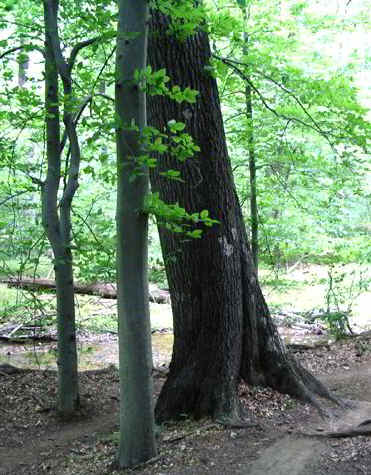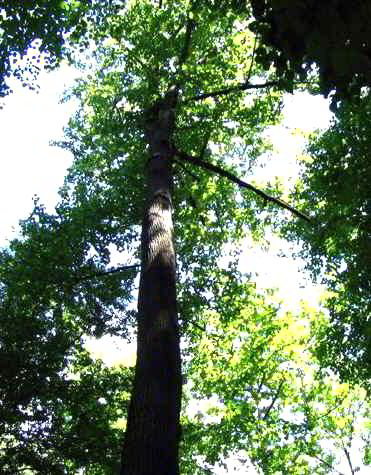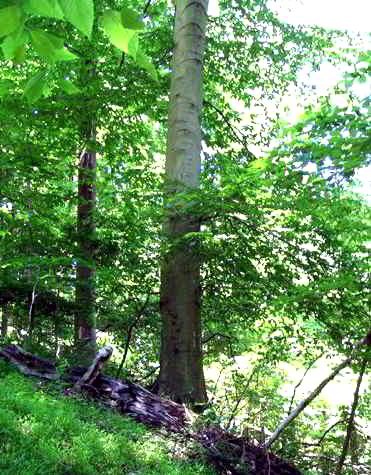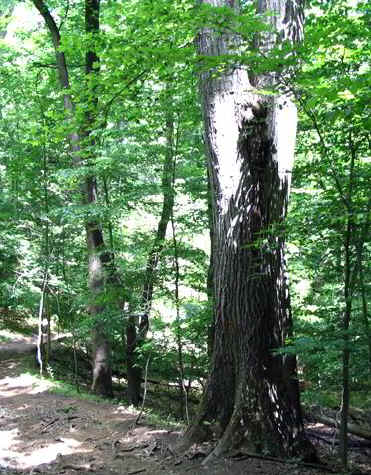Greetings!
I took advantage of the nice weather this weekend and hiked
along one of
the many interesting trails in Patapsco State Park that is
"off the
beaten path". This was the Rockburn Branch Trail, one that
supposedly
goes through a mature forest (which it did).

This photo was taken much deeper in the park,
along the Rockburn Branch stream. Here, there are trees that seem
considerably older mixed in with the more common young to mature trees in
the park. This tulip poplar is an example. Note the gnarled root buttress
that, at least to me, seems to indicate greater that average age. The
understory has its usual heavy population of shade tolerate beech trees in
this area of the park, despite its proximity to a stream.
Anyway, I was mostly there to have fun and enjoy the park, but I
did try
my hand at measuring some of the larger trees... and I really
don't know
how you folks do it so successfully!
Girth: This can be tricky depending upon what plants live under
the
tree, and plenty of trees had vines on them... I don't recall if
poison
ivy or Virginia creeper is the fuzzy-stalked one, so I just
avoided them
both. Also, it works a lot better with 2 people to hole the tape
measure
in place.
Height: This is the real puzzle - how does one measure the
height of a
tree when it seems the only way to see the top is to stand under
it? I
know that clinometers tend to give questionable results, but in
a dense
forest, I can't see any good way of measuring tree height
without using
a laser rangefinder to try to hit a high branch (and even that
is
tricky)
ID: Even this posed challenging. Some stuff was obvious, but
plenty of
trees couldn't be narrowed down to anymore than a family or one
of
several choices. It is tricky when the nearest leaf is 40-feet
up!
Anyway, I still had fun and so I'll write about what I saw.
Sorry for a
lack of any real numbers:

An example of a mature tulip poplar in the highlands of
Patapsco State Park - the photo was taken in the same general area as the
one of the beech tree, on the road leading to the Ridge Road and Rockburn
Branch trails. These tulips poplars, while definitely second-growth, have
achieved respectable height and girth, though they are still young when
compared to the maximum age and size of the species.
- Tulip Trees: These huge trees pretty much rule all of Patapsco
State
Park, at least all the parts I've seen. Rare is the place where
they are
not the tallest and most massive tree. I saw plenty of trees
that were
over 3-feet in diameter, and I'd guess that they were over
100-feet
tall. Tulip Trees are common in both the uplands and the
lowlands,
though they sometimes tip over in the lowlands when the winds
pick up
and the soil is too soft. Hurricanes produce this effect, and
when one
goes down, it may take out its neighbors, too.
- Sycamores (American Sycamore): This species is confined to the
lowlands, where it grows to monstrous size, beating out the
tulip trees
in diameter, though I'd say that it only comes in second in
height, on
average. Still, sycamores that are 3 to 4 feet in diameter and
over
100-feet tall live in the lowlands, so these fellas are BIG.

An example of a mature beech tree in the highlands of
Patapsco State Park. These trees can reach a respectable size (3+ feet in
diameter), though they are generally not the largest tree in any given area.
- American Beech: This species mostly populated the upper areas
of the
park, where seedlings and young trees could be found in
abundance. There
were some older trees as well, though truly big beech trees are
not very
common. I did see one by a path that had the year
"1956" carved into it.
Assuming that the year was accurate and the tree was of decent
size
then, it might be around 80+ years of age now. No sign of
beech-bark
disease, and I shudder to think what it would do to this park
since
American Beech seems to be the primary shade-tolerant species in
the
higher areas. Good size beech trees get over 3-feet in diameter,
but
they are not that big compared to the tulip trees and sycamores.

This tree guards the path to the Ridge Road Trail and is
a good example of the old, gnarled oaks that can be found scattered here and
there through Patapsco. I haven't found any areas of high oak density yet,
but they seem to be everywhere in low numbers, and now and then one will run
into a truly magnificent and gnarled tree, such as this one. The photo
serves to give some scale to the tree; I am pretty sure it's massive,
buttressed trunk was over 4-feet in diameter, though it was tricky to
measure. I don't know what variety of oak it was (all the leaves were way
too high up to be sure), but it was definitely something from the red oak
family, and I think Northern Red oak was a close match.
- Oaks (of all kinds): I haven't found too many dense areas of
oaks, but
small to mid-sizes ones are found here and there, as are some
down-right
HUGE older trees. One beast on the way up the trail had a
diameter of
about 4-feet or more, with a heavily fluted (but not really
flared)
base. It split into two big leaders maybe 15 to 20 feet up. This
big
tree was some variety of red oak - the leaves looked to be
related to
pin, scarlet, or maybe shumard oak. A few other monster oaks
I've seen
lurking in the park of mixed kinds (reds, whites, etc.)
- Ash (green): I found at least one nice sized green ash on the
way up.
Not too big - nothing compared to the really astounding trees,
but it
was still of good size (maybe 2 to 3 feet diameter, 90+ feet
high, I
guess).
- Maples and Box Elders: Confined to the lowland sites, the park
really
doesn't seem to have too many maples, at least not the areas
I've seen.
Box Elders are reasonably common of this group, as are silver
maples.
I've seen a few other types of maples, but not many at all.
There are
some good sized silver maples in the lowlands, but winds and
floods tend
to ruin them.
- Hickories and Walnuts: I've located a few hickories, and I
think they
are pignuts or mockernuts. Supposedly, the park has shagbark
hickories,
but I haven't seen one yet. I've also found black walnuts on the
ground
(without the husk), but I haven't located the trees. No area
that I've
seen has a high concentration of any of these trees, but they
seem to
crop up everywhere, even in lowland areas. None of these trees
have
reached a very impressive size, and one could walk right past
them
without appreciating them if one misses the tell-tale nuts on
the forest
floor.
- Black Locust: This species is growing harder and harder to
find in the
park since it is shade intolerant and short-lived. I found a few
clumps
yesterday in the higher elevations, but all the trees were dead,
dying,
or sick. Most were stricken with that heart-rot fungus that
produces
those brown conks on the trunk.
- Elms (Unknown type, but not American): This was a puzzler, but
I think
I've found a few elms in the park: alternate, saw-toothed oval
leaves,
and the bark and growth seems to match up with some
possibilities...
more research is needed.
- Lindens / Basswoods: These lurk in the park here and there,
given away
by their leaves and bark. However, they grow to such a height
that the
flowers are not obvious until they fall, much like tulip trees.
As for other things of note:
- Invasive: Garlic Muster sadly lurks in the park, creeping
here, there,
and everywhere. It is by far the worst in the lowlands and most
heavily
disturbed areas, but one can find it in small amounts in other
places. I
also know of one area where a wisteria is causing problems, and
I saw a
few trees of heaven lurking near the park entrance. Deep in the
woods,
the situation is much better, at least to my untrained eye - I
am no
expert in this matter, but there are a few pests I can
recognize.
- Weird, ghostly, dead evergreens: I ran into a few of these
deep in the
park. They were modest sized trees in a small group and were all
dead
with no needles on them. I have no idea what species they were;
supposedly the park has some hemlocks in it, so I wondered if I
was
witnessing the work of the Hemlock Wooly Aldegid, but I really
don't
know... it just gave me something to think about.
So, for whatever it is worth, this is my write up on what I saw
from the
perspective of a guy who loves trees and the forest even if he's
not
very good at measuring trees.
Enjoy!
|